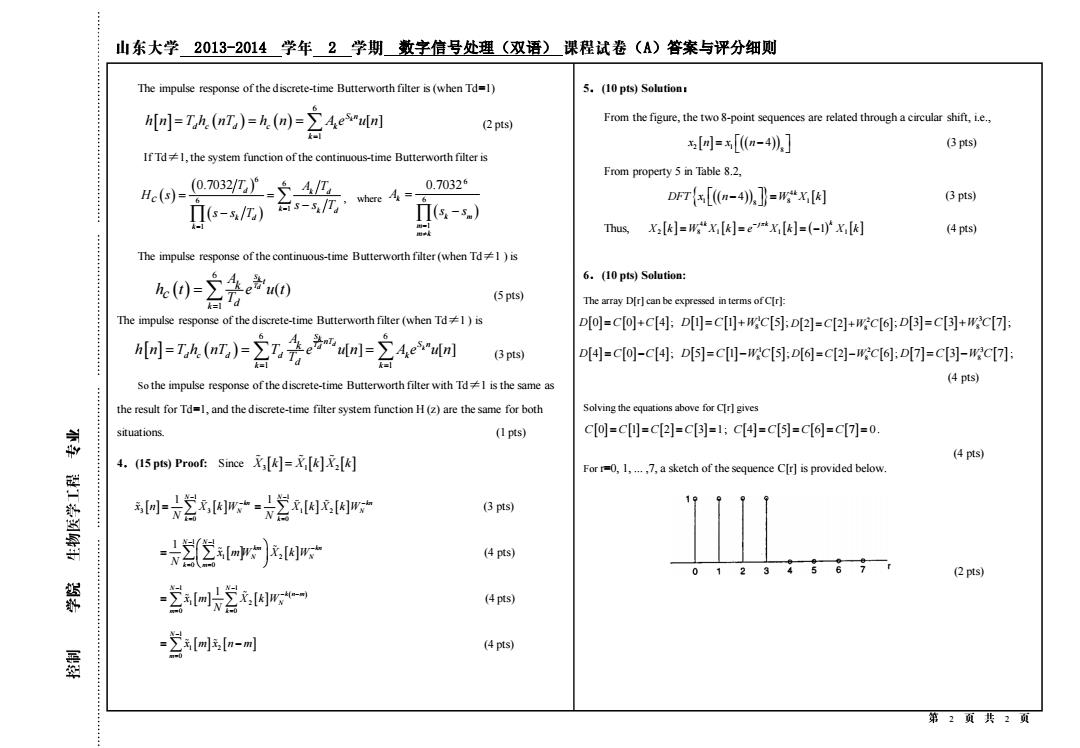正在加载图片...

山东大学2013-2014学年2学期数字信号处理(双语)课程试卷()答案与评分细则 The impulse response of the discrete-time Butterworth filter is(when Td=1) 5.(10 pts)Solution: =A)=A间-宫4 (2pts) From the figure,the two 8-point sequences are related through a circular shift,ie.. [网=[a-4功,] (3 pts) If Td,the system function of the continuous-time Butterworth filter is From property 5 in Table 8.2, Hc(s)=- 070322-4匹 0.70326 s-/万, where DFT{s[n-4),]}=x[个 (3 pts) 6-) Thus, x=xk=e*x=(-旷x (4 pts) The impulse response of the continuous-time Butterworth filter(when Td)is -2*刚 6.(10 pts)Solution: (5pts) The array D[r]can be expressed in terms ofC[r]: The impulse response of the discrete-time Butterworth filter(when Td)is D[o=Co+C[4:D[刊=C刊+c[D[2=C[2+Wc[D[]=C[]+c[小: 阿Am)小宫手-宫44l (3pts) D[4-C0-C4:D[=C[-wc[:D[=CI2-mc:D[]=C[-wc[7]: Sothe impulse response of the discrete-time Butterworth filter with Td is the same as (4 pts) the result for Td=l,and the discrete-time filter system function H(z)are the same for both Solving the equations above for C[r]gives situations. (1 pts) C[o=C[p=c[2=c[3-1;C4=C[=c[6=C[7]=0. 4.(15 pts)Proof:Since]] (4 pts) For r=0,1.....7,a sketch of the sequence C[r]is provided below. 营闲财茗内 (3 pts) 2}时 (4 pts) 56 (2pts) 茶 =2片2 (4 pts) -a-叫 (4pts) 第2项共2页2013-2014 2 数字信号处理(双语) (A)答案与评分细则 2 2 The impulse response of the discrete-time Butterworth filter is (when Td=1) ( ) ( ) 6 1 [ ] k S n d c d c k k h n T h nT h n A e u n = = = = (2 pts) If Td≠1, the system function of the continuous-time Butterworth filter is ( ) ( ) ( ) 6 6 6 1 1 0.7032 d k d k k d k d k c T A T H s s s T s s T = = = = − − , where ( ) 6 6 1 0.7032 k k m m m k A s s = = − The impulse response of the continuous-time Butterworth filter (when Td≠1 ) is ( ) 6 1 ( ) Sk Td t k d k A c T h t e u t = = (5 pts) The impulse response of the discrete-time Butterworth filter (when Td≠1 ) is ( ) 6 6 1 1 [ ] [ ] d k Sk Td nT S n d c d d k k k d k A T h n T h nT T e u n A e u n = = = = = (3 pts) So the impulse response of the discrete-time Butterworth filter with Td≠1 is the same as the result for Td=1, and the discrete-time filter system function H (z) are the same for both situations. (1 pts) 4.(15 pts) Proof: Since X k X k X k 3 1 2 = 1 3 3 0 1 N kn N k x n X k W N − − = = 1 1 2 0 1 N kn N k X k X k W N − − = = (3 pts) 1 1 1 2 0 0 1 N N km kn N N k m x m W X k W N − − − = = = (4 pts) ( ) 1 1 1 2 0 0 1 N N k n m N m k x m X k W N − − − − = = = (4 pts) 1 1 2 0 N m x m x n m − = = − (4 pts) 5.(10 pts) Solution: From the figure, the two 8-point sequences are related through a circular shift, i.e., 2 1 (( ))8 x n x n = − 4 (3 pts) From property 5 in Table 8.2, (( )) 4 1 8 1 8 4 k DFT x n W X k − = (3 pts) Thus, ( ) 4 2 8 1 1 1 1 k k j k X k W X k e X k X k − = = = − (4 pts) 6.(10 pts) Solution: The array D[r] can be expressed in terms of C[r]: D C C 0 0 4 = + ; 1 8 D C W C 1 1 5 = + ; 2 8 D C W C 2 2 6 = + ; 3 8 D C W C 3 3 7 = + ; D C C 4 0 4 = − ; 1 8 D C W C 5 1 5 = − ; 2 8 D C W C 6 2 6 = − ; 3 8 D C W C 7 3 7 = − ; (4 pts) Solving the equations above for C[r] gives C C C C 0 1 2 3 1 = = = = ; C C C C 4 5 6 7 0 = = = = . (4 pts) For r=0, 1, ... ,7, a sketch of the sequence C[r] is provided below. (2 pts)